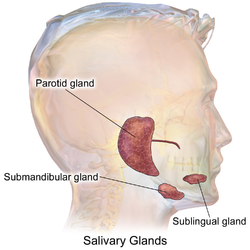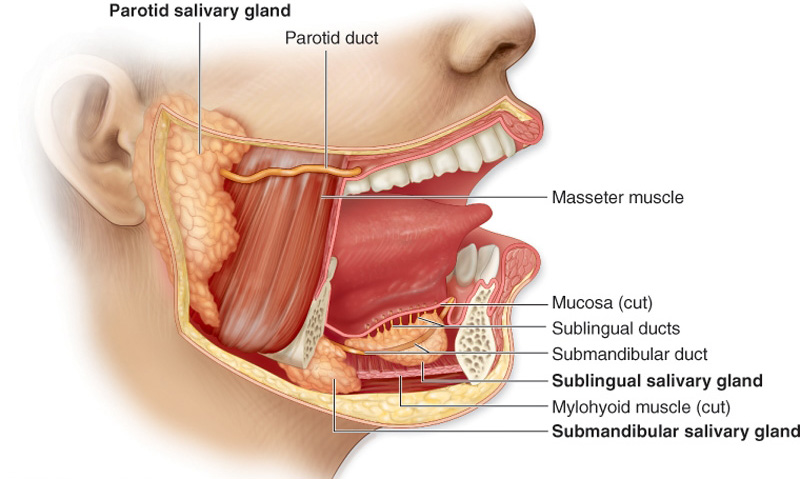
- Salivary glands secrete saliva into the oral cavity.
- Saliva is a watery, tasteless mixture of secretions from the salivary glands and the oral mucous glands.
- There are three main salivary glands: Parotid glands, Submandibular glands and sublingual glands which are present in pairs.
- Parotid glands:
- They are the largest of the three main pairs of salivary glands.
- They lie on the sides of the face, just below and in front of the ears.
- The parotid ducts, also called Stensen’s ducts, open into the vestibule opposite to the upper second molar tooth.
- They secrete water, salts and salivary amylase.
- Unlike other salivary glands, they don’t secrete mucin (a protein that forms mucus when dissolved in water), and as a result, saliva from parotid glands is clear and watery.
- Viral infection (by mumps virus or paramyxo virus) of the parotid glands causing swelling and pain is the disease called mumps.
- Submandibular glands:
- They are located on the medial side of the mandible (lower jaw).
- They are roughly the size of walnuts and are half the size of parotid glands.
- Submandibular ducts or Wharton’s ducts, open on the floor of the mouth behind the lower incisors.
- They secrete water, salts, salivary amylase (less than that from parotid glands) and mucin.

- Sublingual glands:
- They are located in the floor of the mouth beneath the tongue.
- They are the smallest of salivary glands and secrete mostly water, salts and mucin.
- They secrete the most viscous saliva of the three types of glands, with high mucus and low salivary amylase.
Saliva and its functions:
- Saliva is a watery (transparent), viscous fluid secreted by the salivary glands that contains about 99% water and 1% electrolytes and proteins.
- Mucin present in saliva forms mucus when dissolved in water.
- Saliva also consists of salivary amylase or ptyalin.
- Its pH is slightly acidic to neutral ranging from 5.75 to 7.05.
- About 1-1.5 liters of saliva and mucus are secreted daily in the buccal cavity.
- The salivary glands are under the neural control and salivation is activated by the sight, smell, idea and the talk of food and by the presence of food in the buccal cavity.
Functions of saliva:
- It moistens and lubricates the buccal mucosa, tongue and lips, thus making speech possible.
- It also moistens and lubricates the food particles and changes it to a semisolid mass for easy swallowing.
- Salivary amylase or ptyalin immediately acts on carbohydrates, breaking them down into maltose and dextrin.
- Saliva, acting as a solvent, moistens the food and allows it to be tasted as the taste buds are stimulated by the chemicals in the solution.
- Saliva washes or cleanses the mouth and teeth of cellular and food debris.
- The high bicarbonate concentration of saliva helps reduce dental carries by neutralizing the acidity of food in the mouth.
- Antibacterial agent in saliva kills mainly of the bacteria that enter the mouth with food.